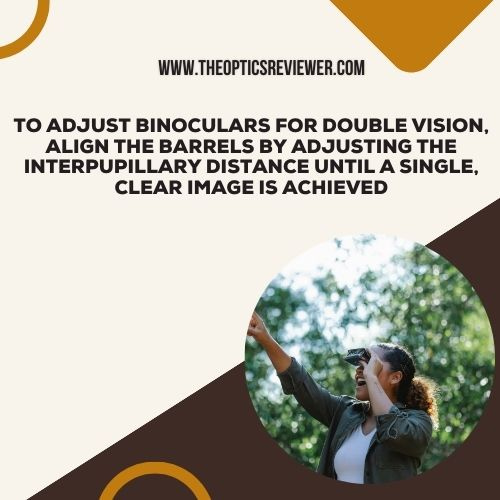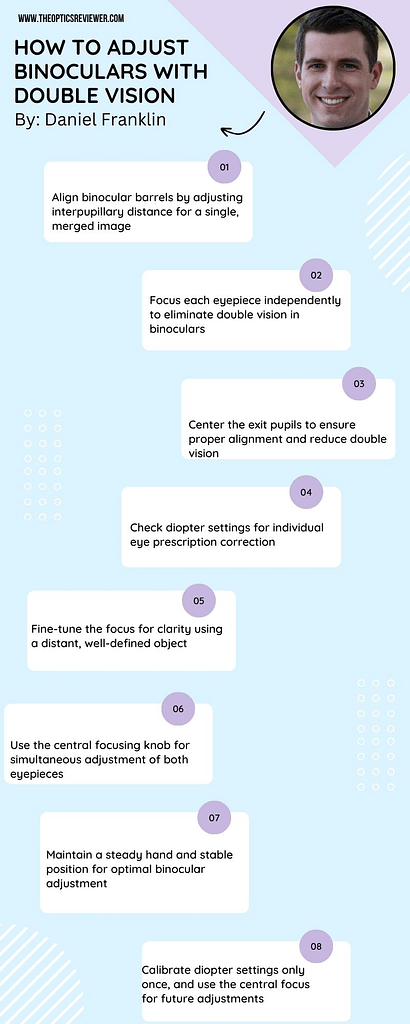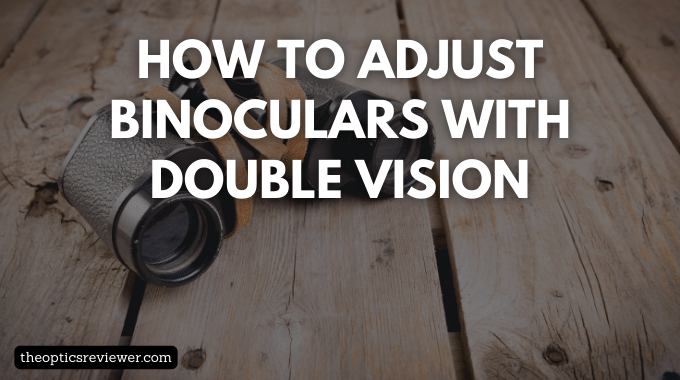How did we get into this situation? The obvious answer is that technology hasn’t evolved as fast as we thought it should. At the same time, when reading on the internet, you’ll encounter many people trying to help train their eyes and pupils on an excellent quality of their vision. But when you ask them about how to adjust binoculars with double vision, – they won’t even know what you mean. So here we come with our best effort to clear up this issue for you.
But before diving deep into how to adjust binoculars with double vision, let us first discuss binocular alignment and double vision.
Contents
- 1 Key Highlights
- 2 What is Binocular Alignment?
- 3 What is Double Vision?
- 4 Why Do I See Double Images When Using Binoculars?
- 5 What is IPD?
- 6 How Can I Spot Horizontal Misalignment?
- 7 How Can I Spot Vertical Misalignment?
- 8 How to Adjust Binoculars With Double Vision?
- 9 Which One is Easier to Adjust, The Roof or The Porro Prism?
- 10 Conclusion
- 11 References
- 12 FAQs
- 12.1 What are Binoculars?
- 12.2 Why Do Binoculars Have Double Vision?
- 12.3 How To Adjust Horizontal Misalignment?
- 12.4 How To Adjust Vertical Misalignment?
- 12.5 What is The Proper Way To Calibrate Binoculars?
- 12.6 How Do You Realign Binoculars?
- 12.7 How Do You Look Through Binoculars With Both Eyes?
- 12.8 How Do You Fix Double Image on Binoculars?
Key Highlights
- Adjust the binoculars by independently adjusting each eyepiece to achieve a sharp and clear focus for both eyes.
- Set the interpupillary distance to match your eyes, ensuring proper alignment and reducing double vision.
- If available, utilize the diopter adjustment on one eyepiece to fine-tune for any differences in vision between your eyes.
- Periodically recalibrate the binoculars to maintain optimal alignment and prevent recurring issues with double vision.
What is Binocular Alignment?
Binoculars are made up of two lenses, one for each eye. When your eyes have to work together to see something, they must be aligned properly so that both lenses can focus on the same point in the scene at the same time. This alignment is called binocular alignment or binocular vision.

What is Double Vision?
Binocular vision can be affected by a problem called double vision. Double vision happens when the binoculars’ two optical barrels are not lined up. Thus, they are not pointing towards the same distant object. It typically occurs when your binoculars have been mishandled, and the prisms and lenses become out of alignment.

Why Do I See Double Images When Using Binoculars?
When using binoculars, it’s possible to perceive double images, and your binoculars’ lack of collimation is the reason for this. If your binoculars are not properly collimated, they won’t be capable of focusing on objects. It is worth mentioning that by adjusting your binoculars’ four adjustment screws, you may collimate them.
What is IPD?
Your two pupils’ centers are separated by a distance called the interpupillary distance or IPD. The interpupillary distance between your eyes must match the distance between the binoculars’ two eyepieces. The binoculars must be adjusted for your unique interpupillary distance because each person has a different one. Remember that you shouldn’t try to make the adjustments until you have the correct IPD.
How Can I Spot Horizontal Misalignment?
What you have to do is to concentrate on the target’s horizontal lines. While maintaining your head still, relax your eyes and alternately close each one for one second. It is worth mentioning that it’s typical for there to be a small amount of movement between each eye’s vision and you need not worry about that, but if you find significant movement, that is a red flag.
Pull your eyes about an inch away from the eyepieces if you believe that your eyes are making up for misalignment and you are unable to see it. Now, focus on the top of your field of vision and scan for apparent horizontal line misalignment.
How Can I Spot Vertical Misalignment?
What you have to do is to concentrate on the target’s vertical lines. While maintaining your head still, relax your eyes and alternately close each one for one second. It is worth mentioning that it’s typical for there to be a small amount of movement between each eye’s vision and you need not worry about that, but if you find significant movement, that is a red flag.
Pull your eyes about three inches away from the binoculars to double-check any misalignment. Instead of attempting to gaze through the binoculars, focus on the image or target as it appears through the eyepieces. Now, focus on the top of your field of vision and scan for apparent vertical line misalignment.
Now, once we have discussed all the background knowledge we ought to have about double vision, let’s move toward our main topic, which is how to adjust binoculars with double vision.
How to Adjust Binoculars With Double Vision?
Binoculars are a type of optical magnification device used by humans and animals. They usually aid in focusing on objects far away and shading out details on the thing due to its better clarity. A good pair of binoculars is a must-have for any history buff or enthusiast.
However, this increases the risk of double vision due to its higher magnification. To avoid this, it is always better to manually adjust your binocular lenses or use an optical control device found at most large electronics stores. We will discuss how to adjust binoculars with double vision for your guidance.
We can divide the whole process into 5 main steps
- Collecting necessary pieces of equipment
- Locating the adjustment screws of your binoculars
- Testing the collimation of your binoculars
- Making the collimation adjustments accordingly
- Refocus the lens and test it out
1. Collecting Necessary Pieces Of Equipment
Before adjusting binoculars with double vision, it is vital to have the necessary equipment at hand. You will need
- Screwdriver
- Razor, scalpel, or pen knife
- Scale
- Cardboard
- Black marker
- Tripod
Once you have collected all the required equipment, it is time to move toward the second step, which is to locate the adjustment screws.
2. Locating The Adjustment Screws Of Your Binoculars
So what you must do is start the whole process by looking for the adjustment screws first. You can take help from the manufacturer’s provided user manual to locate their position. Suppose you do not find such information in the manual or have misplaced the manual. In that case, you can look up on the internet or the manufacturer’s official site for the diagram showing where those adjustment screws are really present.
Now, if your pair of binoculars has a plastic housing covering the screws, you must remove it first. You can do so by taking out any removable screws from the housing of the binoculars, which will ultimately free up the adjustment screws. In case you find non-removable screws, it is preferable not to meddle with the assembly as you can do more harm than good to your binoculars this way.
Now comes the horizontal adjustment screws, which are located just before the eyepieces along the back rim of the binoculars. Just take a scalpel or razor and start above the eyepiece, shave the adhesive covering the rim and work your way outside the binoculars. It is worth mentioning that you should handle the razor with care and should wear thick gloves to avoid any accidental cuts.
To access the vertical screws, scrape back the coating next to the focus knob. It is worth mentioning that until you are positive that those prisms are the issue, you are strongly advised to leave the front screws (those close to the objective lens) alone, or else even a slight mishandling can cause more harm to the adjustment of your binoculars.
Once you have located the adjustment screws of your binoculars, it is time to move towards the second step, which is to test the collimation.
If interested you can read more about best low light binoculars.
3. Testing the Collimation of Your Binoculars
We have reached the third step of how to adjust binoculars with double vision, and to test the collimation of your spy binoculars, you have to make sure that your binoculars are steady. To ensure the steadiness of your binoculars, you can mount them on a tripod to ensure that they will remain still throughout the whole adjustment procedure.
What you have to do is to draw a plus symbol (+) on the cardboard using the scale and a marker. It is worth mentioning that each of the two lines should be 12 inches long. Now, mark every inch on the line you just drew, from 1 to 12. When finished, hang the cardboard at a distance of 100 meters from a tree, a wall, or a stand. Now try to focus on the plus sign you drew on the cardboard. Check to see if the distances between the two tiny lines on the cardboard are identical.
One eye at a time, look through your binocs. If everything is aligned correctly, the likelihood is that one of them is precisely on the plus sign and the other is a little off. Analyze the image that is not in the center. Is it to the center’s right, left, above, or below? If the side that is off falls to the left or right of the center when you look at it, the horizontal has to be adjusted. You must modify the vertical if it is above or below the center. You will need to alter both if it is both right or left and above or below the mark.
4. Making the Collimation Adjustments
You should start with the horizontal screws and rotate one of the screws at a time. Turn it 1/8 of a turn to the right to observe what happens, then reverse the direction. To find out what modifications are necessary, repeat this process for each screw. To bring the images halfway closer, tighten one of the horizontal screws. Afterward, tighten the other one to bring both images together. It is worth noting that the image quality will suffer if you adjust one side, so it’s crucial only to adjust halfway. To keep the image intact, the two sides should be evenly adjusted.
If your images have aligned perfectly, you are good to go; otherwise, adjust the vertical screws to center the images if necessary. In order to bring the images halfway closer, tighten one of the vertical screws. Afterward, tighten the other one till the images are centered.
It is worth mentioning that turning the screws won’t shift the image straight in any direction because the binoculars use prisms to focus the image. Instead, they will cause the images to move diagonally, either left or right, which is the reason that makes the adjustments a little tricky.
You can read more about collimation adjustments here.
5. Refocus the Lens and Test it Out
Turn the right-hand knob back to its original position when you believe the images are overlapping, and then check to see if your overall image quality has improved. Your adjustment was successful if your vision is clear and the double vision has disappeared. So what you have to do is to close your eyes for five seconds, then open them again to see whether the collimation is better. Your collimation is successful if the object continues to appear as a single image. You still need to make extra adjustments if it seems to be two separate images that suddenly blend.
You can read how to focus your binoculars properly here.
Which One is Easier to Adjust, The Roof or The Porro Prism?
Roof prism binoculars are substantially more difficult to adjust than Porro prism ones. The geometry of the pair demonstrates how these two designs function. Roof prisms are sleek and frequently portrayed as portable or compact, but Porro prisms are typically bulkier and have the characteristic hefty binoculars look.
Conclusion
So we have thoroughly discussed how to adjust binoculars with double vision, and we hope that you would have understood the whole process. All in all, you need to adjust the collimation of your binoculars to eliminate the double vision problem.
However, it is worth mentioning that if the warranty still covers your binoculars, the manufacturer will correct the collimation for no charge, so before attempting to adjust the screws yourself, get in touch with them first. Moreover, if the whole process seems really complicated to you and your product has also outlived the warranty period, it is better to seek professional help and go to a repair shop.
References
- https://www.researchgate.net/profile/Mario-Pirchio/publication/22441278_Binocular_vision_tested_with_visual_evoked_potentials_in_children_and_infants/links/0fcfd5092b3a08b971000000/Binocular-vision-tested-with-visual-evoked-potentials-in-children-and-infants.pdf
- https://onlinelibrary.wiley.com/doi/abs/10.1111/j.1755-3768.1978.tb01375.x‘
- https://link.springer.com/article/10.1007/BF00248221
- https://www.cell.com/neuron/pdf/S0896-6273(21)00158-6.pdf
FAQs
What are Binoculars?
Binoculars enhance vision, allowing clear observation of stars, landscapes, and details like fine decorations. They are valuable tools for activities such as stargazing, wildlife spotting, and providing a closer look at unnoticed scenes.
Why Do Binoculars Have Double Vision?
When using binoculars, it’s possible to perceive double images, and your binoculars’ lack of collimation is the reason for this. If your binoculars are not properly collimated, they won’t be capable of focusing on objects. It is worth mentioning that by adjusting your binoculars’ four adjustment screws, you may collimate them.
How To Adjust Horizontal Misalignment?
The screw closest to the viewer can be slightly adjusted to change the horizontal alignment. You can totally skip this step if it is your vertical and not horizontal alignment that needs adjustments. If both of them require adjusting, initiate with the horizontal one and make sure it is precisely where you need it before making the transition.
How To Adjust Vertical Misalignment?
The vertical adjustment requires more delicate handling. The screw that is closest to the objective lens should be adjusted to change the vertical alignment. When you’re done, use some high-quality rubber adhesive if the rubber won’t snap back over the screws because you tore it up to get to the adjustment screws.
What is The Proper Way To Calibrate Binoculars?
Close your right eye, and focus on a distant object with your left eye. You can adjust the binoculars to your eyes with the help of the central focus. Next, close your left eye and focus your right eye using the focusing ring on the right eyepiece. This makes up for the difference in your eyes’ acuity.
How Do You Realign Binoculars?
To realign binoculars, focus on a distant object using one eyepiece, then close that eye and adjust the focus using the central diopter wheel with the other eye. Repeat until both eyes provide a clear view, ensuring proper alignment for comfortable and accurate viewing.
How Do You Look Through Binoculars With Both Eyes?
To use binoculars with both eyes, adjust the interpupillary distance to match your eyes, then focus using the central focusing wheel. Keep both eyes open for a comfortable and balanced viewing experience.
How Do You Fix Double Image on Binoculars?
To fix a double image on binoculars, adjust the interpupillary distance by moving the barrels closer or farther apart until a single merged image is obtained. Additionally, fine-tune the focus on each eyepiece to ensure clarity and eliminate the double vision. If the issue persists, professional repair may be needed.

